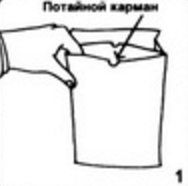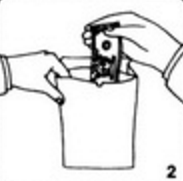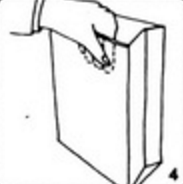 Free technical library
Free technical library
Double Wall Paper Bag - Disappearance. Tips for a magician

Directory / Spectacular tricks and their clues
 Comments on the article
Comments on the article
If you made it right double wall bag, then there should be no problems when demonstrating the "disappearance" of an object.
Let's say your one dollar bill is about to disappear.
1. You take a bag from the table (the side with the secret pocket should be closest to you) and open it. You hold the bag with your left hand. The thumb of the left hand should be outside, and the index finger should be in a secret pocket, the remaining three fingers should be in the main compartment. This means that the secret pocket is ajar. Keep the bag slightly (slightly) tilted away from the audience so that the audience does not see the second wall.

2. Take the dollar with your right hand and put it in the secret pocket of your bag.

3. With your left hand, place the bag on the table in full view of the audience so that the secret pocket is on the back side.
4. Demonstrating the disappearance, take the bag from the back side, pinching the hidden pocket so that it does not open.

5. Note. When you grab the back of the bag with your left hand, you pinch both the back of the bag and the second wall of the secret pocket with your fingers. With your fingers, you securely close the secret pocket.
6. Make a magical gesture "dollar, disappear" and grab the front, unprepared wall of the bag with your right hand. Tear open the bag, tearing off the unprepared wall and completely opening the bag, which contains nothing. The dollar you just put in your bag has "disappeared".

7. Having shown that the bag is empty, crush the remains of it and put it aside or throw it backstage. Treat it with ease, but be careful: the dollar, lying in a secret pocket, should not "light up".
Author: Mark Wilson
 We recommend interesting articles Section Spectacular tricks and their clues:
We recommend interesting articles Section Spectacular tricks and their clues:
▪ Moving bottle and glass
▪ Ace Houdini
▪ Mechanical Cardboard Replacement Card Box
 See other articles Section Spectacular tricks and their clues.
See other articles Section Spectacular tricks and their clues.
 Read and write useful comments on this article.
Read and write useful comments on this article.
<< Back
 Latest news of science and technology, new electronics:
Latest news of science and technology, new electronics:
Air trap for insects
01.05.2024
Agriculture is one of the key sectors of the economy, and pest control is an integral part of this process. A team of scientists from the Indian Council of Agricultural Research-Central Potato Research Institute (ICAR-CPRI), Shimla, has come up with an innovative solution to this problem - a wind-powered insect air trap. This device addresses the shortcomings of traditional pest control methods by providing real-time insect population data. The trap is powered entirely by wind energy, making it an environmentally friendly solution that requires no power. Its unique design allows monitoring of both harmful and beneficial insects, providing a complete overview of the population in any agricultural area. “By assessing target pests at the right time, we can take necessary measures to control both pests and diseases,” says Kapil ... >>
The threat of space debris to the Earth's magnetic field
01.05.2024
More and more often we hear about an increase in the amount of space debris surrounding our planet. However, it is not only active satellites and spacecraft that contribute to this problem, but also debris from old missions. The growing number of satellites launched by companies like SpaceX creates not only opportunities for the development of the Internet, but also serious threats to space security. Experts are now turning their attention to the potential implications for the Earth's magnetic field. Dr. Jonathan McDowell of the Harvard-Smithsonian Center for Astrophysics emphasizes that companies are rapidly deploying satellite constellations, and the number of satellites could grow to 100 in the next decade. The rapid development of these cosmic armadas of satellites can lead to contamination of the Earth's plasma environment with dangerous debris and a threat to the stability of the magnetosphere. Metal debris from used rockets can disrupt the ionosphere and magnetosphere. Both of these systems play a key role in protecting the atmosphere and maintaining ... >>
Solidification of bulk substances
30.04.2024
There are quite a few mysteries in the world of science, and one of them is the strange behavior of bulk materials. They may behave like a solid but suddenly turn into a flowing liquid. This phenomenon has attracted the attention of many researchers, and we may finally be getting closer to solving this mystery. Imagine sand in an hourglass. It usually flows freely, but in some cases its particles begin to get stuck, turning from a liquid to a solid. This transition has important implications for many areas, from drug production to construction. Researchers from the USA have attempted to describe this phenomenon and come closer to understanding it. In the study, the scientists conducted simulations in the laboratory using data from bags of polystyrene beads. They found that the vibrations within these sets had specific frequencies, meaning that only certain types of vibrations could travel through the material. Received ... >>
 Random news from the Archive Random news from the Archive Innovative production of 3D nanochips
27.07.2013
New microscopy technology will facilitate the development and control of the production of XNUMXD semiconductor chips.
Scientists from the National Institute of Standards and Technology (NIST) have upgraded the optical microscopy technology they developed several years ago and adapted it to observe nano-sized objects, which allows them to control the production of elements of three-dimensional semiconductor chips of a new generation. With the help of this technology, called TSOM (Through-Focus Scanning Optical Micr), one can not only examine the nanoscale components of chips, which until recently were two-dimensional structures, but also determine differences in their shapes and sizes with a sufficiently high accuracy, which is required for carrying out technological control.
New generations of semiconductor chips are composed of three-dimensional elements that are superimposed on each other. For the correct and reliable operation of the chip as a whole, it is required that all components have the correct shape and strictly specified dimensions. Existing methods of microscopy - electron, atomic force and others - can provide control of the shape and size of chip elements, but they do it extremely slowly, with the risk of damaging the fragile structure of the chip, and they are also extremely expensive. And the use of optical microscopy methods is limited by the fact that the dimensions of the chip elements are much smaller than half the wavelength of visible light (250 nm for green light), so an optical microscope cannot physically see such small objects.
TSOM technology allows you to see optically objects that are approximately 10 nm in size, and even smaller in the future. The TSOM method uses a conventional optical microscope that takes not one, but many defocused XNUMXD images of an object of interest from multiple viewpoints. Using the brightness changes from these out-of-focus shots, the computer calculates light gradients and defines the boundaries of the objects being shot, thus creating the resulting three-dimensional image.
The images obtained using the TSOM method are somewhat abstract, but the details that are visible on them make it possible to determine differences in the shapes and sizes of semiconductor chip components with a fairly high accuracy.
"Our research has shown that with TSOM, we can view elements as small as 10 nm, which is enough to control semiconductor manufacturing processes for the next decade," says Ravikiran Attota, a scientist at NIST. TSOM technology can be used not only in the electronics industry, but also in other industries, in science and everywhere where it is necessary to analyze and control the shapes of tiny three-dimensional objects."
|
 Other interesting news:
Other interesting news:
▪ 5 GHz processor
▪ Huawei Watch D with blood pressure monitor and ECG
▪ Smartphone providing free unlimited communication
▪ Stratostatic Internet
▪ planet diamond
 News feed of science and technology, new electronics
News feed of science and technology, new electronics
 Interesting materials of the Free Technical Library:
Interesting materials of the Free Technical Library:
▪ radio section of the website. Article selection
▪ article An ordinary loop becomes springy. Tips for the home master
▪ article When were wheeled bags invented? Detailed answer
▪ okra article. Legends, cultivation, methods of application
▪ article Superregenerator with a switched LC circuit. Encyclopedia of radio electronics and electrical engineering
▪ article Vacuum luminescent indicators ILC1-1/7, ILC2-1/7, ILC1-1/9. Encyclopedia of radio electronics and electrical engineering
 Leave your comment on this article:
Leave your comment on this article:
 All languages of this page
All languages of this page
Home page | Library | Articles | Website map | Site Reviews

www.diagram.com.ua
2000-2024







 Arabic
Arabic Bengali
Bengali Chinese
Chinese English
English French
French German
German Hebrew
Hebrew Hindi
Hindi Italian
Italian Japanese
Japanese Korean
Korean Malay
Malay Polish
Polish Portuguese
Portuguese Spanish
Spanish Turkish
Turkish Ukrainian
Ukrainian Vietnamese
Vietnamese





 See other articles Section
See other articles Section 